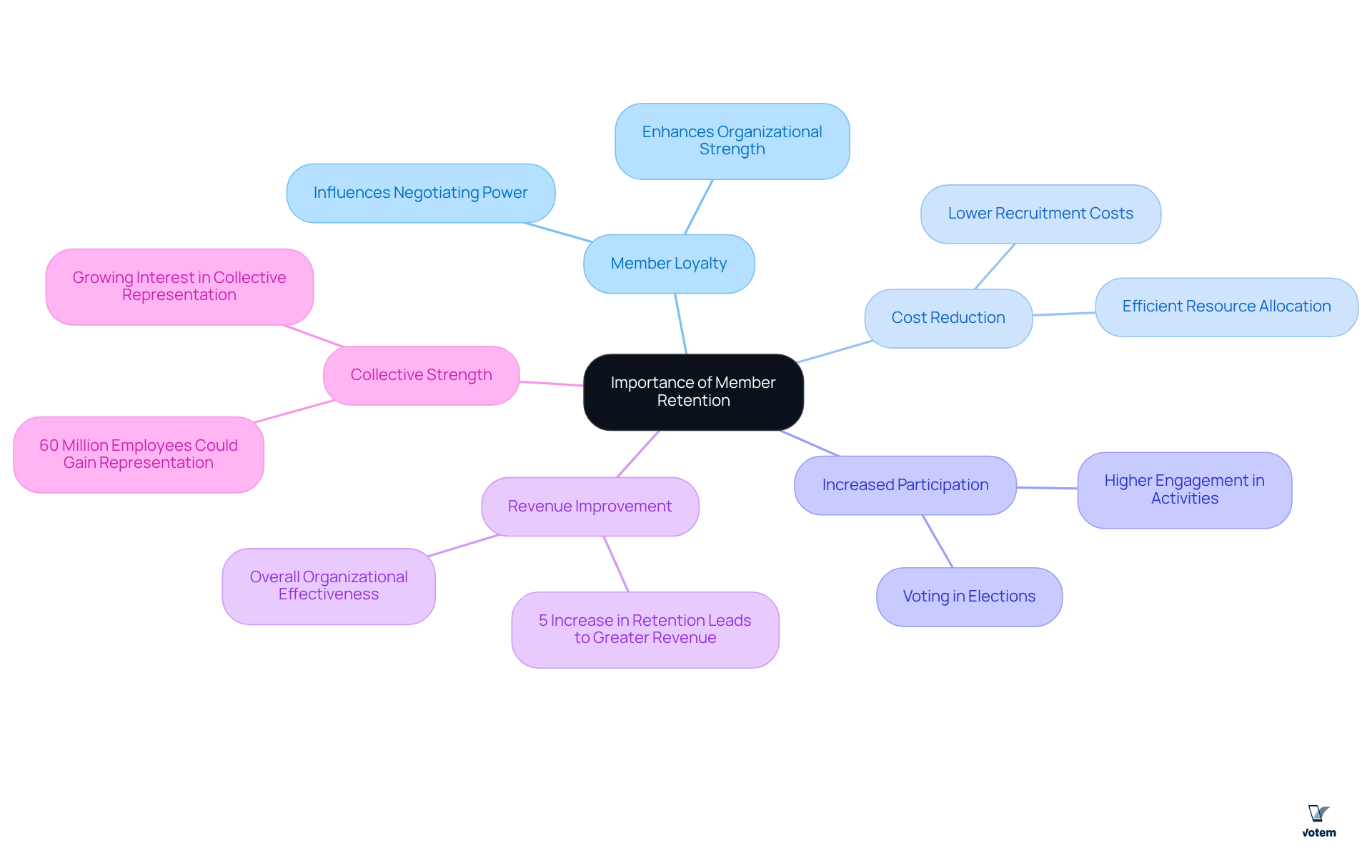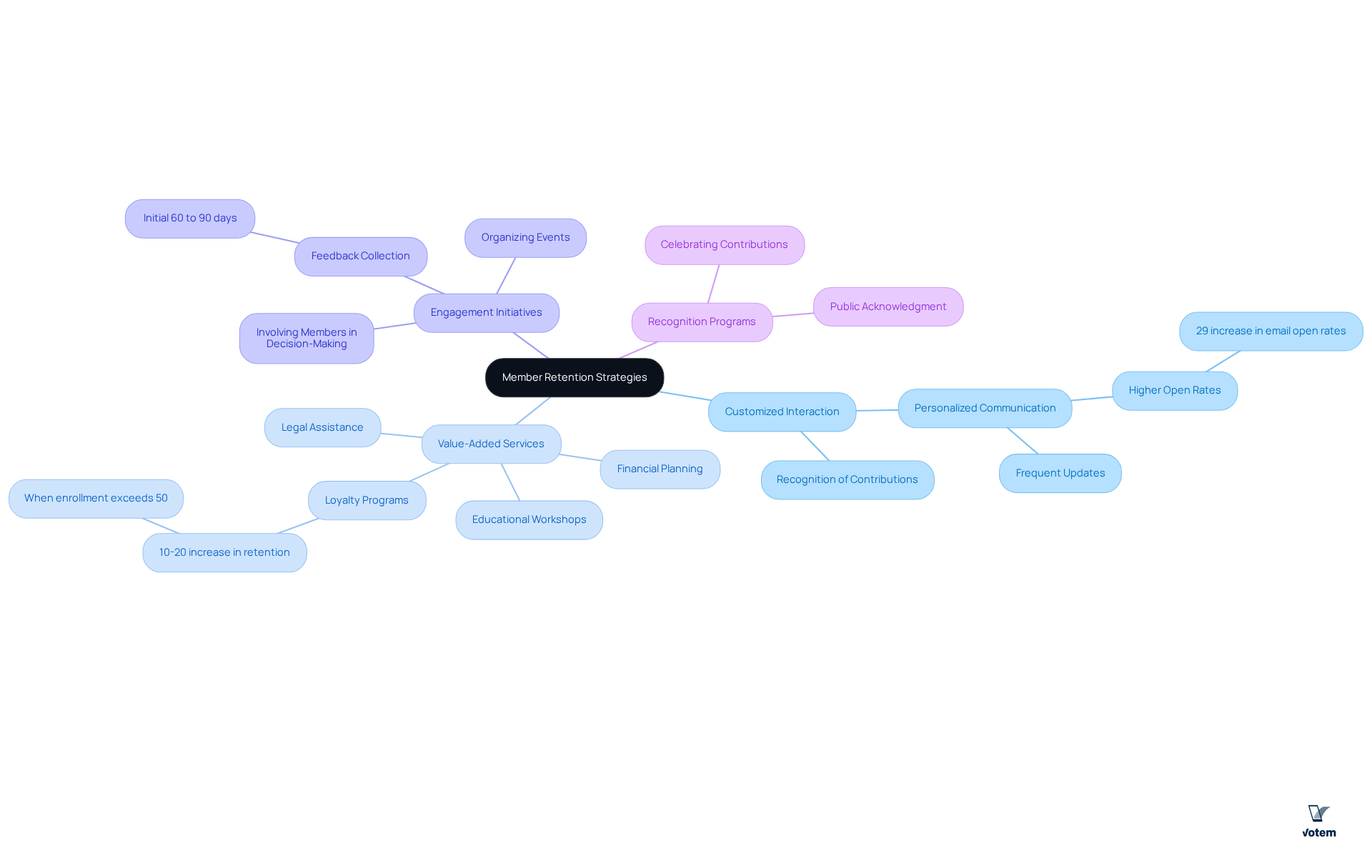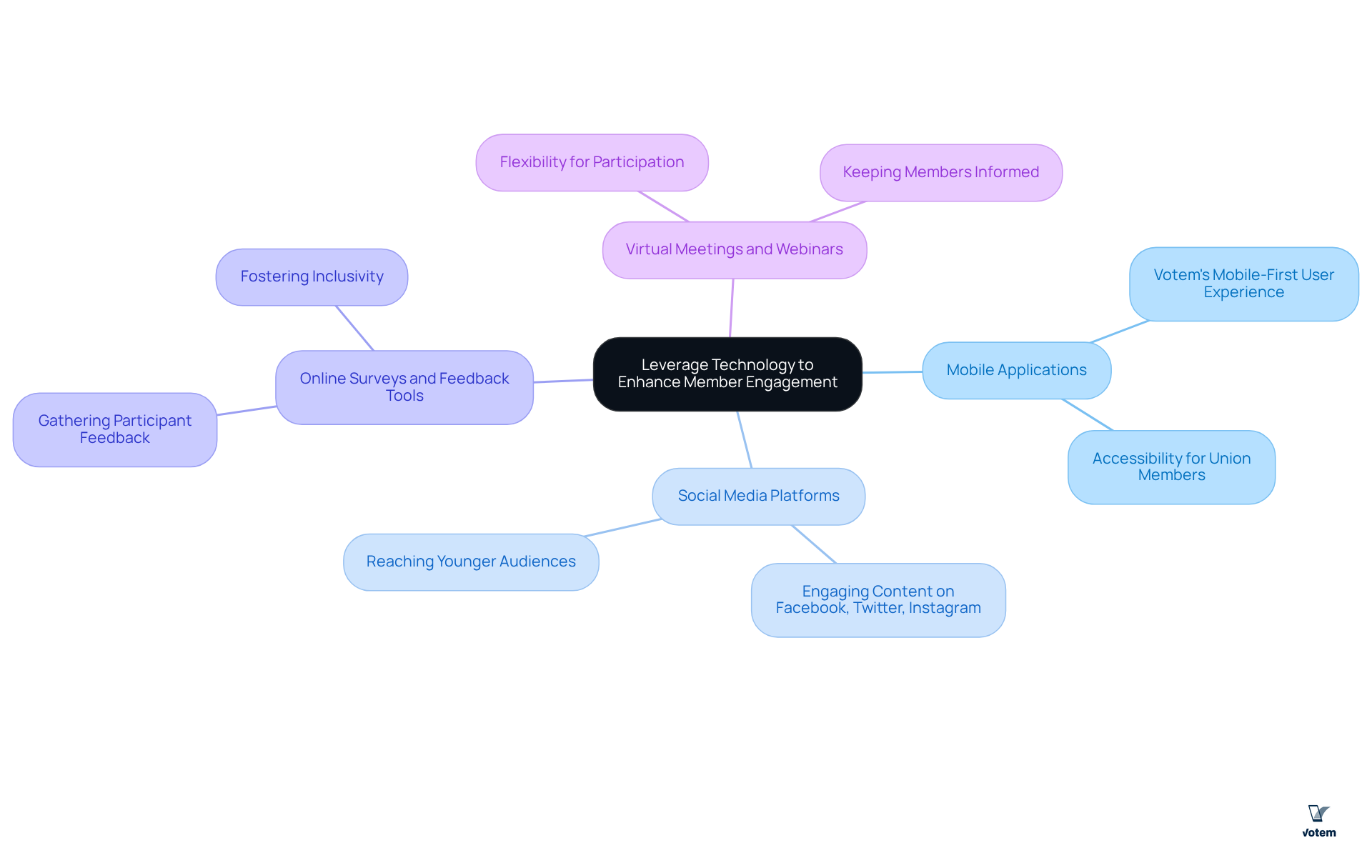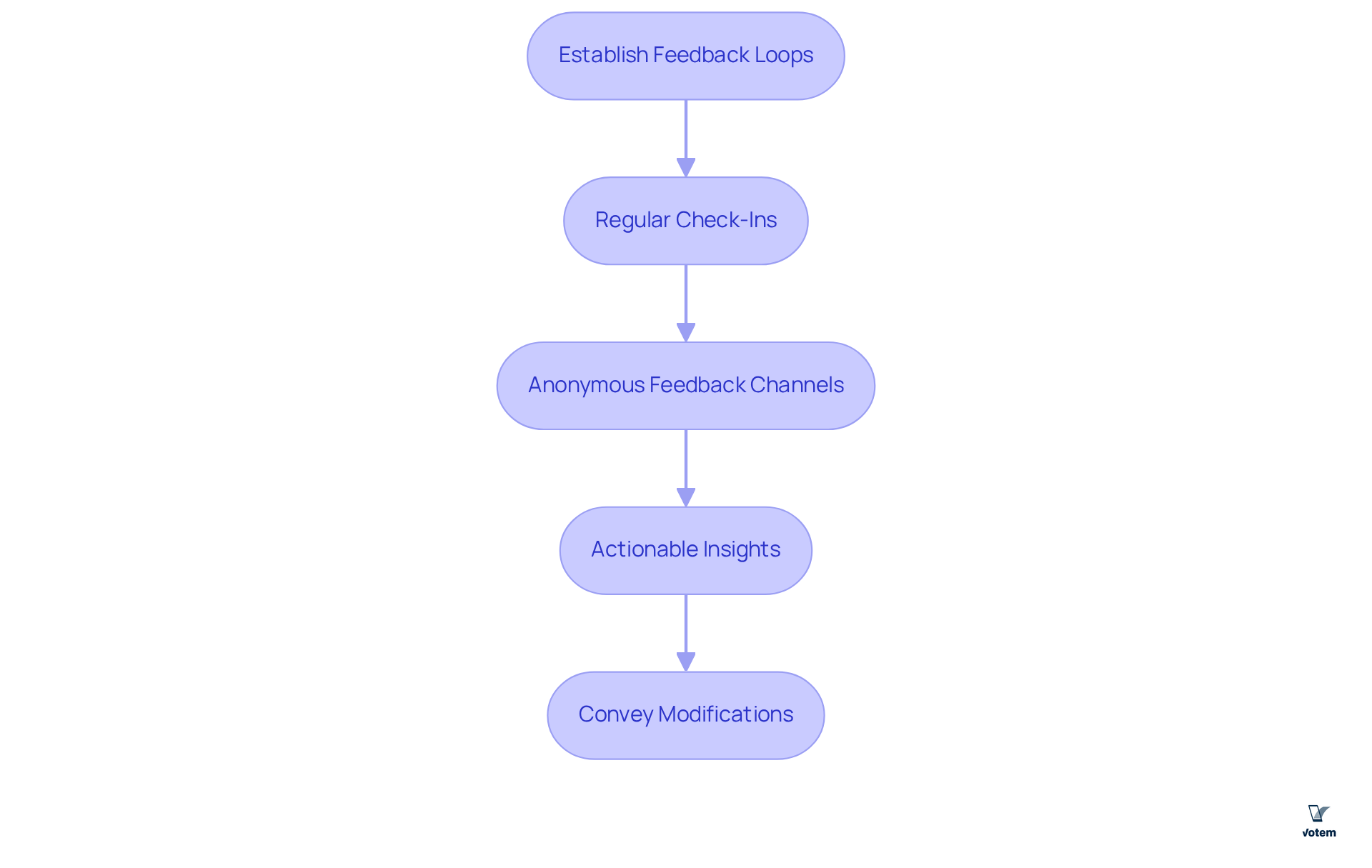Overview
This article delineates four pivotal strategies for union member retention, underscoring the necessity of:
- Customized interaction
- Value-added services
- Engagement initiatives
- Recognition programs
Firstly, personalized communication is paramount; evidence indicates that it significantly boosts member engagement. Secondly, value-added services, alongside recognition programs, cultivate loyalty and satisfaction among members. These elements are not mere enhancements; they are essential for fortifying the union’s negotiating power and overall effectiveness. In conclusion, implementing these strategies will not only retain members but also strengthen the union’s position in negotiations.
Introduction
The vitality of member retention in unions is paramount; it directly influences their negotiating power and overall effectiveness. As organizations strive to enhance their collective strength, understanding and implementing effective retention strategies is essential. What are the most effective methods to ensure that members feel valued and engaged, thereby fostering loyalty? This article explores four innovative strategies that unions can adopt to not only retain members but also elevate their commitment and involvement within the organization.
Understand the Importance of Member Retention for Unions
Member loyalty is crucial for associations, directly influencing their strength and negotiating power. High retention of members not only reflects participant satisfaction but also significantly enhances the organization’s negotiating capabilities. Engaged individuals are more inclined to participate in organizational activities, cast votes in elections, and support collective bargaining initiatives.
Furthermore, the retention of members helps to reduce the costs associated with hiring and training new ones, enabling organizations to allocate resources more effectively. Studies show that even a modest 5% increase in retention can lead to and overall organizational effectiveness. Notably, over 60 million American employees could gain representation if mobilized, underscoring the broader implications of improved membership continuity on collective strength.
Additionally, the percentage of non-affiliated workers willing to vote for an organization has surged from one-third to 50%, indicating a growing interest in collective representation. Neglecting strategies for the retention of members can result in higher recruitment costs and diminished negotiating power, making it imperative for organizations to prioritize this aspect.
For instance, Votem’s CastIron platform has successfully managed over 13 million votes, demonstrating how technology can enhance participant engagement and trust in the electoral process. By emphasizing the retention of members, organizations can foster loyalty and commitment, ultimately strengthening their position in negotiations and ensuring a more powerful collective voice.

Implement Effective Strategies for Member Retention
To effectively retain members, unions should consider implementing the following strategies:
- Customized Interaction: Adapting communication to address the specific needs and interests of individuals is essential. Frequent updates regarding collective activities, benefits, and achievements promote a sense of belonging and involvement. Tailored communication—such as addressing individuals by name and recognizing their contributions—can significantly strengthen their connection to the union. In fact, studies indicate that personalized messages in email campaigns can lead to 29% higher open rates, underscoring the importance of this approach.
- Value-Added Services: Providing services that enhance the value of membership, including legal assistance, financial planning, and educational workshops, can significantly boost satisfaction and loyalty among participants. Emphasizing these advantages in communications ensures individuals are informed about the resources accessible to them, which can enhance retention rates. For instance, loyalty programs that benefit current participants can result in a 10-20% rise in retention when enrollment exceeds 50%.
- [Engagement Initiatives](https://votem.com/7-strategies-to-engage-union-voters-effectively): Organizing events, workshops, and social gatherings fosters participation and strengthens connections to the organization. Involving participants in decision-making processes and union activities not only cultivates a sense of community but also boosts commitment. Effective engagement strategies have been shown to increase attendance and renewal rates, which are essential for the retention of members in the long term. Furthermore, gathering feedback from participants during the initial 60 to 90 days of involvement can yield valuable insights into their experiences and requirements.
- Recognition Programs: Implementing recognition programs that celebrate contributions and achievements fosters a positive environment and encourages ongoing participation. Publicly acknowledging individuals’ efforts cultivates a sense of value and appreciation, which is vital for maintaining engagement. As noted, recognizing the achievements of individuals can greatly influence their sense of belonging within the organization.
By concentrating on these tactics, organizations can cultivate a supportive and engaging environment that motivates individuals to remain active and dedicated.

Leverage Technology to Enhance Member Engagement
Technology plays a crucial role in enhancing participant involvement within organizations. To leverage technology effectively, consider the following strategies:
- Mobile Applications: Develop a mobile app that provides users with easy access to union news, events, and resources. A mobile-first strategy significantly enhances engagement, especially among younger individuals. For instance, Votem’s mobile-first user experience has been shown to increase voter turnout by up to three times on launch day, underscoring the potential impact of such technology.
- Social Media Platforms: Utilize social media to engage with individuals, share updates, and promote events. Engaging content on platforms like Facebook, Twitter, and Instagram fosters a sense of community and encourages participation. With over 90% of individuals owning smartphones, is essential for effectively reaching younger audiences.
- Online Surveys and Feedback Tools: Implement online surveys to gather feedback from participants on various issues. This approach not only demonstrates that the organization values participant opinions but also helps identify areas for improvement. Actively seeking feedback fosters a more inclusive atmosphere and showcases the organization’s commitment to its constituents.
- Virtual Meetings and Webinars: Organize virtual meetings and educational webinars to engage participants who may be unable to attend in-person events. This flexibility enhances involvement and keeps individuals informed about organizational activities, ensuring that everyone has the opportunity to participate, regardless of their location.
By embracing technology, organizations can [cultivate a more connected and engaged membership base](https://votem.com/10-essential-features-of-a-ranked-choice-voting-generator/), ultimately contributing to the retention of members and increased loyalty rates.

Establish Feedback Loops to Adapt Retention Strategies
Establishing successful communication cycles is essential for unions aiming to enhance the retention of members strategies. To achieve this, consider the following key steps:
- Regular Check-Ins: Conduct routine check-ins with participants to discuss their experiences and gather feedback. This can be accomplished through individual meetings, focus groups, or surveys, ensuring that participants feel heard and appreciated. As Tim McAlpine, CEO of Currency Marketing, states, “Actively engage with participants through surveys, focus groups and open communication channels.”
- Anonymous Feedback Channels: Implement anonymous channels for members to express their thoughts and concerns. This method promotes sincere input, enabling unions to recognize problems that may not emerge in open discussions, thus .
- Actionable Insights: Analyze the responses gathered to identify common themes or areas for improvement. Utilizing this data to guide decision-making is crucial for enhancing strategies that focus on the retention of members and ensuring they align with user expectations. For instance, organizations that proactively pursue and respond to input can significantly improve participant satisfaction. The University of Hertfordshire’s Sports Village achieved a 73% retention rate after making adjustments based on feedback, showcasing the efficacy of such strategies.
- Convey Modifications: After implementing changes based on input, it is vital to communicate these updates to participants. This practice demonstrates that the organization values their input and is committed to ongoing enhancement, reinforcing trust and involvement. Research indicates that organizations that effectively complete the communication cycle observe improved metrics in participant satisfaction and loyalty.
By establishing robust feedback loops, organizations can ensure the effectiveness of their retention of members strategies, making them responsive to participant needs and ultimately fostering a loyal and engaged constituency. Furthermore, as credit union participant satisfaction declined from 88.4% in 2020 to 86.5% in 2021, it underscores the necessity for unions to proactively seek input from their constituents to avert similar downturns. Additionally, Votem’s capability to manage over 13 million votes while emphasizing security and transparency illustrates the critical role of trust in member engagement.

Conclusion
Member retention stands as a cornerstone of union strength and effectiveness, directly impacting their capacity to negotiate and advocate for members’ rights. By prioritizing retention strategies, unions can cultivate loyalty and enhance their negotiating power, ultimately leading to a more robust collective voice. This focus not only reflects participant satisfaction but also translates into significant cost savings and increased organizational efficiency.
The article outlines several effective strategies for improving member retention, including:
- Personalized communication
- Value-added services
- Engaging initiatives
- Recognition programs
Each of these approaches fosters a sense of belonging and commitment among members, ensuring they remain active participants in union activities. Furthermore, leveraging technology—through mobile applications, social media, and feedback tools—plays a crucial role in enhancing member engagement and satisfaction.
In a competitive landscape where union membership is vital for collective bargaining power, the importance of adopting these retention strategies cannot be overstated. By implementing these best practices and actively seeking member feedback, unions can not only improve retention rates but also strengthen their overall effectiveness. The commitment to fostering a supportive and engaging environment will ensure that unions continue to thrive and represent the interests of their members effectively.
Frequently Asked Questions
Why is member retention important for unions and associations?
Member retention is crucial for unions and associations as it directly influences their strength and negotiating power. High retention reflects participant satisfaction and enhances the organization’s negotiating capabilities.
How does engaged membership affect organizational activities?
Engaged members are more likely to participate in organizational activities, vote in elections, and support collective bargaining initiatives, which strengthens the organization.
What are the financial benefits of retaining members?
Retaining members reduces costs associated with hiring and training new members, allowing organizations to allocate resources more effectively. A modest 5% increase in retention can lead to significant improvements in revenue and overall effectiveness.
What is the potential impact of improved membership continuity on collective strength?
Improved membership continuity could enable over 60 million American employees to gain representation if mobilized, highlighting the broader implications for collective strength.
What trend has been observed regarding non-affiliated workers’ willingness to support organizations?
The percentage of non-affiliated workers willing to vote for an organization has increased from one-third to 50%, indicating a growing interest in collective representation.
What are the risks of neglecting member retention strategies?
Neglecting member retention strategies can lead to higher recruitment costs and diminished negotiating power, making it essential for organizations to prioritize member retention.
How can technology aid in member engagement and retention?
Technology, such as Votem’s CastIron platform, can enhance participant engagement and trust in the electoral process, thereby promoting member retention and loyalty.
List of Sources
- Understand the Importance of Member Retention for Unions
- The Future of Unions (https://news.gallup.com/opinion/polling-matters/392027/future-unions.aspx)
- AFGE Condemns Trump’s Retaliatory Attempt to Outlaw Federal Unions (https://afge.org/publication/afge-condemns-trumps-retaliatory-attempt-to-outlaw-federal-unions)
- Labor unions, with power and popularity rising, are still trailing in the biggest nationwide battle (https://cnbc.com/2024/01/28/unions-with-power-popularity-rising-are-still-losing-a-big-battle.html)
- Pro-labor Republicans push Trump to rescind order busting most federal unions (https://govexec.com/workforce/2025/04/pro-labor-republicans-push-trump-rescind-order-busting-most-federal-unions/404249)
- Workers want unions, but the latest data point to obstacles in their path: Private-sector unionization rose by more than a quarter million in 2023, while unionization in state and local governments fell (https://epi.org/publication/union-membership-data)
- Implement Effective Strategies for Member Retention
- Boost Member Retention: Top 4 Strategies in 2025 (https://interface.ai/blog/boost-member-retention-top-4-strategies)
- [Report] Why Members Don’t Renew and How to Prevent It (https://blog.imis.com/member-retention-report)
- Member retention made easy for small associations: Top strategies for 2025 (https://yourmembership.com/blog/member-retention)
- Effective Email Campaigns for Union Member Retention – Six Degrees Digital Media (https://sixdegreesdigitalmedia.com/effective-email-campaigns-for-union-member-retention)
- Credit Union Member Retention Strategies, 2025 (https://defisolutions.com/answers-old/how-technology-helps-improve-credit-union-member-retention)
- Leverage Technology to Enhance Member Engagement
- Engaging Younger Union Members with Technology (https://nepmedia.net/post/engaging-younger-union-members-with-technology)
- Unions gather to share, learn and strategize on AI’s “perils and promises” (https://uniglobalunion.org/news/unions-gather-to-share-learn-and-strategize-on-ais-perils-and-promises)
- uniontrack.com (https://uniontrack.com/blog/digital-union-engagement)
- ulanetwork.com (https://ulanetwork.com/blog/how-unions-are-using-technology-to-organize-and-amplify-their-voice)
- cnwr.com (https://cnwr.com/blog/empowering-labor-unions-with-it-enhancing-member-engagement-and-communication)
- Establish Feedback Loops to Adapt Retention Strategies
- Fix Your Feedback Loop for Engagement & Retention • Glue Up (https://glueup.com/blog/fix-unstructured-feedback-loops-member-engagement)
- Feedback Loop in CX: What It Is & Why It Matters | InMoment (https://inmoment.com/blog/customer-feedback-loop)
- Four winning plays for connecting with members – Ohio Credit Union League (https://ohiocreditunions.org/four-winning-plays-for-connecting-with-members)
- Member retention success: Understanding surveys and feedback loops (https://retentionguru.com/blog/member-retention-success-understanding-surveys-and-feedback-loops)
- The importance of member retention in growing credit unions — Currency Marketing (https://currencymarketing.ca/blog/the-importance-of-member-retention)

